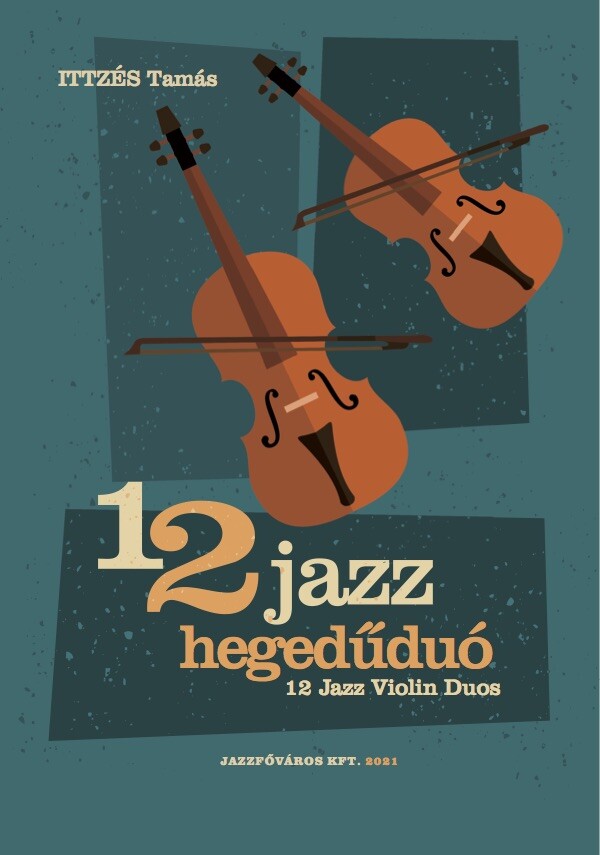 Those fortunate enough to have attended any of the Bohém Ragtime Jazz Festivals, presented annually in Hungary, or viewed its videos on YouTube, know that it features some of the best international performers in creating a world-class event. The festival is led by Tamás Ittzés 1, himself an outstanding jazz pianist and violinist. Aside from the collection under review here, he has a few other publications: 16 Lightsome Pieces for Trumpet or Alto Saxophone with Piano Accompaniment (1999), and a couple of cadenzas for Mozart and Haydn violin concertos.
Those fortunate enough to have attended any of the Bohém Ragtime Jazz Festivals, presented annually in Hungary, or viewed its videos on YouTube, know that it features some of the best international performers in creating a world-class event. The festival is led by Tamás Ittzés 1, himself an outstanding jazz pianist and violinist. Aside from the collection under review here, he has a few other publications: 16 Lightsome Pieces for Trumpet or Alto Saxophone with Piano Accompaniment (1999), and a couple of cadenzas for Mozart and Haydn violin concertos.
Writing cadenzas for classical concertos might seem a departure from Ittzés’s usual jazz focus, but a connection lies with the improvisatory nature of cadenzas, sections in which the soloist muses upon and freely plays with themes already heard in the concerto. Whereas most classical concertos have cadenzas written by their composers, tradition allows the soloist to compose new cadenzas, either prior to performance or extemporaneously. When Mozart performed his piano concertos, he probably improvised his cadenzas. That Tamas Ittzés is equally at ease with both jazz and classical traditions demonstrates the wide breadth of his musical life, reflected also in the quality and diversity of these jazz violin duos.
On learning of these duos, I went to YouTube to hear them performed by the composer, who plays both parts (listen here). The first piece, Groundish and Noble – Cakewalk, initially had me wondering why it almost sounded familiar. But I quickly stopped my mental search for a title as I realized the music is not a copy of a cakewalk from the original ragtime years. Rather, it is a synthesis of the cakewalk idea, placed into an entirely new, original setting.
Each of the duos features a different idea, sometimes identified explicitly by the titles. A few might be considered études in that they build upon particular performance techniques. Quint-essence is a title used to indicate both excellence and almost continuous fifths (perfect, diminished, and augmented), played as double stops—i.e., on two strings simultaneously to produce two pitches. Single notes and occasional sixths and thirds appear, but fifths are dominant throughout. I initially assumed that Quadruple Stops would be double stops for two violins. It starts off that way, but eventually both violins play quadruple stops—four strings either plucked or, when bowed, quickly arpeggiated or as two double stops. Despite this concentration on a performance technique of some difficulty, the swinging, jazz feel is never lost, that being true of all the numbers in this collection.
Plucking the Swing refers to a piece performed entirely with pizzicato, the plucking of strings. Beneath the effect of that technique is an interesting manipulation of the opening theme, which appears in several guises throughout, sometimes with rhythmic variants, other times with motivic extensions.
The following number, Ostinato (a term that indicates an unchanging melody, usually in a lower part), re-uses the opening theme of Plucking the Swing, but now as an ostinato theme played arco (with the bow). The ostinato continues for about half of the piece, sometimes with slight variants, before giving way temporarily for a few choruses of a 12-bar blues, then ending with the original ostinato.
A type of brief ostinato used in jazz is the riff, though it’s not restricted to a lower part and usually appears as a succession of variant riffs. That’s what happens with Licks and Riffs, a piece with a chain of swing-styled riffs that are varied and developed, but without any overriding melodic theme. Ostinatos (or riffs) also play a part in Sliding Flagolet, in which the main performance feature is harmonics—tones an octave or an octave-and-a-fifth higher than would be indicated by the finger position, produced by pressing the string only partially without having it touch the fingerboard.
Not all numbers focus on particular performance techniques. Ragging the Tango, as the title suggests, merges the two syncopated styles, featuring traits of both. Csiga (Snail) Blues presents a blues theme in several variations, followed by a second blues theme (and a brief reference to Gerhswin’s Rhapsody in Blue) and a simulation of a walking bass before returning to the opening theme. The collection is filled with such gems. They are always interesting, frequently challenging, and never lose the swinging spirit of jazz.
12 Jazz Violin Duos can be purchased at www.bohemragtime.com/en/scores.html with PayPal, using either PayPal credit or a credit card. The package includes separate scores for each violin as well as a complete score showing both violin parts. The price for the digital version is 25 EUR, about $29–$30 US; a print copy (including shipping) is 32 EUR, or $38–$39 US.





















